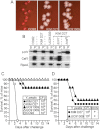Hereditary hemochromatosis restores the virulence of plague vaccine strains
- PMID: 22896664
- PMCID: PMC3501692
- DOI: 10.1093/infdis/jis433
Hereditary hemochromatosis restores the virulence of plague vaccine strains
Abstract
Nonpigmented Yersinia pestis (pgm) strains are defective in scavenging host iron and have been used in live-attenuated vaccines to combat plague epidemics. Recently, a Y. pestis pgm strain was isolated from a researcher with hereditary hemochromatosis who died from laboratory-acquired plague. We used hemojuvelin-knockout (Hjv(-/-)) mice to examine whether iron-storage disease restores the virulence defects of nonpigmented Y. pestis. Unlike wild-type mice, Hjv(-/-) mice developed lethal plague when challenged with Y. pestis pgm strains. Immunization of Hjv(-/-) mice with a subunit vaccine that blocks Y. pestis type III secretion generated protection against plague. Thus, individuals with hereditary hemochromatosis may be protected with subunit vaccines but should not be exposed to live-attenuated plague vaccines.
Figures






Similar articles
-
Rational considerations about development of live attenuated Yersinia pestis vaccines.Curr Pharm Biotechnol. 2013;14(10):878-86. doi: 10.2174/1389201014666131226122243. Curr Pharm Biotechnol. 2013. PMID: 24372254 Free PMC article. Review.
-
Live-attenuated Yersinia pestis vaccines.Expert Rev Vaccines. 2013 Jun;12(6):677-86. doi: 10.1586/erv.13.42. Expert Rev Vaccines. 2013. PMID: 23750796 Review.
-
Vaccination with live Yersinia pestis primes CD4 and CD8 T cells that synergistically protect against lethal pulmonary Y. pestis infection.Infect Immun. 2007 Feb;75(2):878-85. doi: 10.1128/IAI.01529-06. Epub 2006 Nov 21. Infect Immun. 2007. PMID: 17118978 Free PMC article.
-
An encapsulated Yersinia pseudotuberculosis is a highly efficient vaccine against pneumonic plague.PLoS Negl Trop Dis. 2012;6(2):e1528. doi: 10.1371/journal.pntd.0001528. Epub 2012 Feb 14. PLoS Negl Trop Dis. 2012. PMID: 22348169 Free PMC article.
-
A Yersinia pestis guaBA mutant is attenuated in virulence and provides protection against plague in a mouse model of infection.Microb Pathog. 2010 May;48(5):191-5. doi: 10.1016/j.micpath.2010.01.005. Epub 2010 Jan 22. Microb Pathog. 2010. PMID: 20096773 Free PMC article.
Cited by
-
Protection and Safety Evaluation of Live Constructions Derived from the Pgm- and pPCP1- Yersinia pestis Strain.Vaccines (Basel). 2020 Feb 21;8(1):95. doi: 10.3390/vaccines8010095. Vaccines (Basel). 2020. PMID: 32098032 Free PMC article.
-
Buried Treasure: Evolutionary Perspectives on Microbial Iron Piracy.Trends Genet. 2015 Nov;31(11):627-636. doi: 10.1016/j.tig.2015.09.001. Epub 2015 Sep 29. Trends Genet. 2015. PMID: 26431675 Free PMC article. Review.
-
Spatially distinct neutrophil responses within the inflammatory lesions of pneumonic plague.mBio. 2015 Oct 13;6(5):e01530-15. doi: 10.1128/mBio.01530-15. mBio. 2015. PMID: 26463167 Free PMC article.
-
Genetic and Dietary Iron Overload Differentially Affect the Course of Salmonella Typhimurium Infection.Front Cell Infect Microbiol. 2017 Apr 11;7:110. doi: 10.3389/fcimb.2017.00110. eCollection 2017. Front Cell Infect Microbiol. 2017. PMID: 28443246 Free PMC article.
-
Combinatorial Viral Vector-Based and Live Attenuated Vaccines without an Adjuvant to Generate Broader Immune Responses to Effectively Combat Pneumonic Plague.mBio. 2021 Dec 21;12(6):e0322321. doi: 10.1128/mBio.03223-21. Epub 2021 Dec 7. mBio. 2021. PMID: 34872353 Free PMC article.
References
-
- Yersin A. La peste bubonique à Hong-Kong. Ann Inst Pasteur. 1894;2:428–30.
-
- Simond PL. La propagation de la peste. Ann Inst Pasteur. 1898;12:625–87.
-
- Girard G. Plague. Annu Rev Microbiol. 1955;9:253–77. - PubMed
Publication types
MeSH terms
Substances
Grants and funding
LinkOut - more resources
Full Text Sources
Other Literature Sources
Medical

